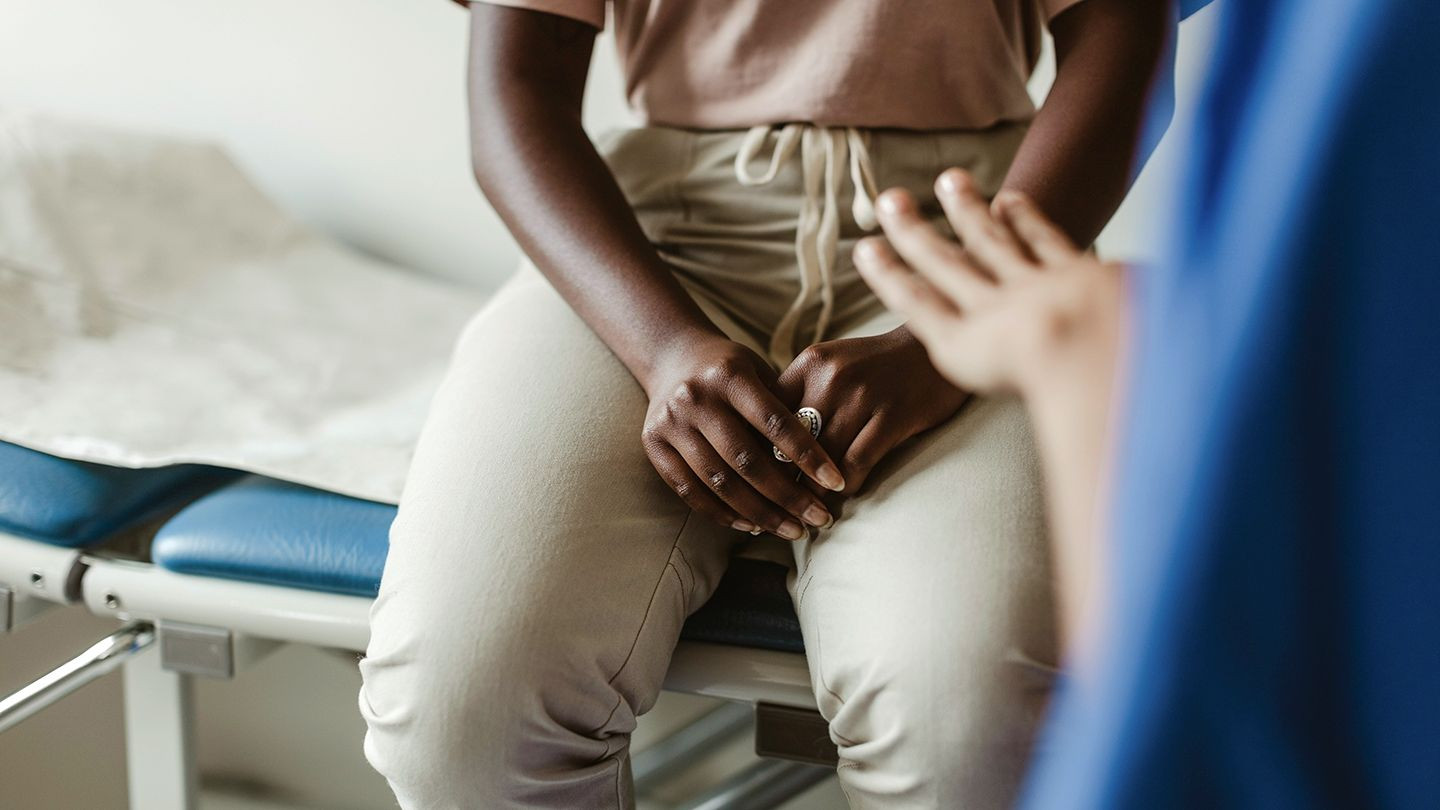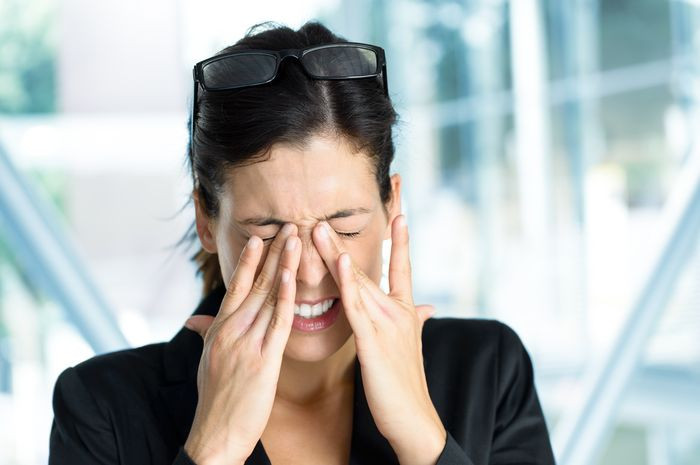Definisi
Abses multipel kelenjar keringat (hidradenitis supuratif) adalah penyakit kulit yang menyebabkan lenting-lenting kecil dan bekas luka. Pada umumnya, kondisi ini terjadi pada daerah-daerah kulit dengan kelenjar keringat banyak, seperti pada selangkangan, dubur, payudara, dan ketiak. Penyakit ini juga dikenal dengan nama acne inversa.
Penyebab
Penyakit ini terjadi apabila folikel rambut (tempat tumbuhnya rambut) tersumbat. Namun, penyebab sumbatan belum diketahui secara pasti. Penyebab sumbatan diduga berkaitan dengan hormon, genetik, merokok, atau berat badan berlebih. Penyakit ini tidak disebabkan oleh infeksi atau kebiasaan hidup jorok, serta tidak dapat ditularkan kepada orang lain.
Folikel rambut ini terletak dekat dengan kelenjar keringat. Setelah tersumbat folikel rambut ini bisa ruptur atau pecah, dan membuat kandungannya seperti keratin dan bakteri keluar ke lapisan kulit (dermis) di sekitarnya. Diduga terjadi respon peradangan oleh sel-sel darah putih tubuh sehingga terjadi pembentukan abses yang memungkinkan nanah berkumpul.
Faktor Risiko
Abses multipel kelenjar keringat memiliki faktor risiko berupa:
- Usia, kondisi ini banyak terjadi setelah pubertas, terutama pada usia 20-an hingga 30-an
- Jenis kelamin, abses kelenjar keringat lebih banyak terjadi pada wanita dibandingkan dengan pria
- Orang berkulit hitam lebih sering mengalami kondisi ini dibandingkan dengan orang berkulit putih
- Riwayat keluarga, jika ada anggota keluarga yang mengalami hal serupa, Anda berisiko lebih tinggi mengalami kondisi ini
- Kondisi tertentu
- Obesitas
- Jerawat yang cukup parah
- Peradangan sendi
- Diabetes
- Sindrom metabolik (penyakit terkait gula darah, kolesterol, tekanan darah tinggi, serta obesitas)
- Inflammatory bowel disease (IBD)
- Merokok, orang yang merokok berisiko lebih tinggi mengalami abses kelenjar keringat
Gejala
Abses multipel kelenjar keringat biasanya menyerang kedua bagian tubuh (misalnya kedua ketiak, kedua payudara, dan sebagainya). Anda dapat memiliki beberapa benjolan dalam waktu bersamaan. Bentuk keluhan kulit yang dapat timbul adalah sebagai berikut:
- Bintik hitam, dapat ditemukan pada daerah kulit yang melekuk ke dalam, dan biasanya berpasangan
- Benjolan seukuran kacang polong yang nyeri
- Kondisi ini biasanya dimulai dengan satu benjolan di bawah kulit yang terasa nyeri dan bertahan hingga beberapa minggu atau bulan
- Benjolan dapat bertambah, biasanya pada daerah yang memiliki banyak kelenjar keringat dan kelenjar minyak, atau pada daerah kulit saling bersentuhan, seperti pada ketiak, selangkangan, dubur, dan payudara
- Benjolan atau luka pecah, benjolan dan luka dapat bertambah besar, pecah, dan mengalirkan nanah dengan bau yang tidak sedap
- Terowongan di bawah kulit yang menghubungkan benjolan-benjolan dapat terbentuk seiring waktu, luka seperti ini membutuhkan waktu yang sangat lama untuk sembuh, dan dapat mengalirkan darah atau nanah
Gejala yang muncul pada setiap orang dapat berbeda-beda. Ada orang yang hanya mengalami gejala ringan, namun ada pula yang mengalami gejala sangat berat. Biasanya, gejala yang lebih berat berkaitan dengan berat badan berlebih dan merokok. Namun, tidak menutup kemungkinan bahwa orang yang kurus dan tidak merokok dapat mengalami gejala berat. Gejala yang berat dapat berupa benjolan yang berjumlah banyak, bekas luka, serta nyeri berkepanjangan hingga sulit menggerakkan bagian tubuh yang terkena.
Diagnosis
Untuk mendiagnosis abses multipel kelenjar keringat, dokter tidak memerlukan pemeriksaan khusus. Dokter dapat menanyakan riwayat penyakit seperti kapan benjolan muncul, nyeri, riwayat gejala serupa sebelumnya, serta bila ada anggota keluarga yang pernah mengalami kondisi serupa. Jika ditemukan nanah, dokter dapat mengambil sampel nanah tersebut untuk pemeriksaan laboratorium. Pemeriksaan laboratorium ini bertujuan untuk menentukan jenis bakteri yang ada pada nanah, karena kondisi ini biasanya tidak terkait dengan bakteri yang dapat menyebabkan infeksi pada kulit.
Dokter juga dapat menentukan derajat keparahan abses berdasarkan hasil pemeriksaan. Penentuan derajat keparahan ini penting untuk menentukan terapi yang akan diberikan.
Tata Laksana
Abses multipel kelenjar keringat merupakan kondisi yang dapat terjadi berulang kali dan sulit diterapi. Sangat penting untuk menangani penyakit ini pada derajat ringan, karena pada derajat ringan, penyakit ini dapat dikontrol dengan obat-obatan. Apabila sudah jatuh ke derajat yang lebih berat, prosedur bedah dapat menjadi pilihan terapi.
Terapi abses multipel kelenjar keringat dapat mencakup:
1. Kompres Hangat
Jika kasus Anda tergolong ringan, Anda dapat mencoba kompres hangat selain mengonsumsi obat-obatan yang diresepkan dokter. Kompres dilakukan dengan memasukkan saputangan bersih ke air hangat yang kemudian diletakkan pada area kulit selama 10 menit.
2. Obat Antinyeri
Obat antinyeri seperti ibuprofen dapat menurunkan rasa nyeri dan mengecilkan pembengkakan.
3. Antibiotik
Antibiotik diberikan untuk melawan infeksi bakteri. Hal ini diperlukan karena penyumbatan pada folikel rambut dapat menyebabkan bakteri berkumpul dan berkembang biak secara berlebihan, sehingga menyebabkan infeksi dan menghasilkan nanah. Antibiotik dapat diberikan dengan cara diminum atau dioleskan pada bagian yang sakit.
4. Obat-Obatan Lainnya
Obat antiradang seperti steroid dapat disuntikkan ke dalam benjolan untuk meredakan radang, nyeri, dan bengkak. Pada kasus yang parah, dokter dapat meresepkan obat minum. Selain obat antiradang, retinoid juga bisa menjadi pilihan terapi pada kasus yang tergolong berat.
5. Pembedahan
Jika benjolan melibatkan lapisan kulit yang cukup dalam, dokter dapat menyarankan pembedahan. Pembedahan dapat dilakukan untuk mengalirkan nanah keluar atau memperbaiki kulit yang sering sakit. Dokter dapat menggunakan cangkok kulit untuk melakukan prosedur tersebut. Terapi laser juga dapat menjadi pertimbangan dokter
Selain terapi di atas, Anda juga dapat melakukan perubahan gaya hidup seperti:
- Menurunkan berat badan apabila berlebih untuk mengurangi gesekan antar kulit
- Berhenti merokok dapat meredakan gejala pada abses multipel kelenjar keringat, Anda dapat berdiskusi dengan dokter terkait program berhenti merokok
- Jangan mencukur bagian kulit yang nyeri karena dapat memperparah iritasi
- Menggunakan pakaian longgar karena pakaian ketat dapat menyebabkan kulit bergesekan dan memperparah gejala
- Menjaga agar tubuh tetap dingin karena terlalu banyak berkeringat dapat memperparah gejala, namun hati-hati juga terhadap penggunaan deodoran karena dapat mengiritasi kulit
- Menjaga kebersihan area kulit yang sakit dengan jari Anda, hindari penggunaan kain karena dapat menyebabkan iritasi
- Anda dapat menggunakan sabun antibakteri, yang dapat membantu menghilangkan bau tidak sedap
Jangan lupa untuk menggunakan plester yang tepat. Jika ada benjolan yang bocor, Anda dapat menutupinya dengan plester yang tidak menempel pada benjolan. Anda dapat menggunakan petroleum jelly pada plester tersebut. Sebaiknya, Anda menghindari penggunaan plester yang menempel pada kulit, karena dapat menyebabkan nyeri.
Komplikasi
Komplikasi dari abses multipel kelenjar keringat dapat berupa:
- Daerah yang sakit sangat rentan terhadap infeksi, namun keberadaan nanah belum tentu merupakan pertanda infeksi
- Luka dapat sembuh namun meninggalkan bekas mirip tali tambang atau menyebabkan kulit melekuk ke dalam
- Luka dan bekas luka dapat membatasi gerakan, terutama luka yang masih nyeri, pada daerah ketiak atau selangkangan
- Abses multipel kelenjar keringat dalam jangka panjang dikaitkan dengan kanker kulit, seperti keganasan pada sel skuamosa di lapisan kulit
- Bagian yang sering mengalami abses dekat dengan kelenjar getah bening, sehingga jaringan parut bekas luka dapat menyumbat aliran getah bening dan dapat menyebabkan pembengkakan
- Lokasi, aliran, dan bau nanah dapat menyebabkan rasa malu dan ketidakinginan untuk keluar ke tempat umum, sehingga dapat menyebabkan gangguan cemas atau gangguan depresi
Pencegahan
Abses multipel kelenjar keringat sulit untuk dicegah, namun perjalanan penyakitnya dapat diperlambat dengan bantuan obat-obatan serta memperbaiki gaya hidup. Memperbaiki gaya hidup dapat dilakukan dengan melakukan cara yang sudah dijelaskan pada bagian Tata Laksana.
Kapan Harus ke Dokter?
Abses multipel kelenjar keringat yang didiagnosis lebih awal sangat penting agar terapi berjalan efektif. Anda dapat segera ke dokter apabila mengalami rasa nyeri, sulit bergerak, gejala tidak membaik setelah berobat beberapa minggu, gejala muncul kembali setelah hilang, gejala muncul pada beberapa bagian tubuh secara bersamaan, serta gejala seringkali muncul. Abses multipel kelenjar keringat bukanlah sekadar lepuh yang hilang dalam beberapa hari, melainkan sebuah kondisi kesehatan yang seringkali terkait dengan kondisi kesehatan lainnya. Penyakit ini memerlukan kolaborasi berbagai cabang ilmu kedokteran agar dapat tertangani dengan baik.
Mau tahu informasi seputar penyakit lainnya, cek di sini ya!
- dr Hanifa Rahma
Hidradenitis suppurativa - Symptoms and causes. (2022). Retrieved 28 March 2022, from https://www.mayoclinic.org/diseases-conditions/hidradenitis-suppurativa/symptoms-causes/syc-20352306
Hidradenitis suppurativa (HS). (2019). Retrieved 28 March 2022, from https://www.nhs.uk/conditions/hidradenitis-suppurativa/
Hidradenitis Suppurativa | Acne Inversa | MedlinePlus. (2021). Retrieved 28 March 2022, from https://medlineplus.gov/hidradenitissuppurativa.html
Kam, K., & Bhargava, H. (2020). Hidradenitis Suppurativa. Retrieved 28 March 2022, from https://www.webmd.com/skin-problems-and-treatments/hidradenitis-suppurativa#1
Ballard, K., Shuman, VL. (2022). Hidradenitis Suppurativa. Retrieved 29 March 2022, from https://www.ncbi.nlm.nih.gov/books/NBK534867/












